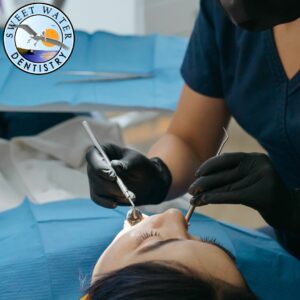Are There Alternatives to a Root Canal? Exploring Your Best Options
Root canals have long been a go-to treatment for saving severely damaged or infected teeth. However, many patients seek alternatives due to concerns about discomfort, cost, or the desire for a more holistic approach to dental care. The good news is that there are several alternatives to a root canal, depending on the condition of the tooth and your overall oral health.
In this blog, we’ll explore the various root canal alternatives, their benefits, and how you can make an informed decision about your dental care.
Understanding the Need for a Root Canal
A root canal is typically recommended when a tooth’s pulp becomes infected or severely decayed. The pulp contains nerves, blood vessels, and connective tissue, and once it’s compromised, it can lead to severe pain, abscess formation, and even systemic health issues if left untreated. Root canals aim to remove the infected pulp, disinfect the inner tooth, and seal it to prevent further infection.
While effective, root canals can be costly and may not always be the best solution for every patient. That’s why many people look for alternatives that align with their health priorities and financial situations.
1. Direct Pulp Capping (For Early Decay)
If decay or injury has only slightly exposed the pulp, a direct pulp cap can help protect and preserve the tooth without a full root canal. This procedure involves:
- Cleaning the area
- Applying a biocompatible material like calcium hydroxide or mineral trioxide aggregate (MTA)
- Sealing the tooth to promote healing and prevent infection
This option works best for minimal exposure and when no infection is present.
2. Indirect Pulp Treatment (For Deep Cavities)
Similar to direct pulp capping, indirect pulp therapy is another conservative treatment. It is often used for children or adults with deep cavities but no active infection. Dentists remove most of the decay but leave a small portion to avoid exposing the pulp directly. A protective material is then applied to encourage healing.
This method can sometimes prevent the need for a root canal if the tooth remains stable and symptoms don’t worsen.
3. Ozone Therapy (A Natural Approach)
Ozone therapy is a more holistic and minimally invasive approach that uses ozone gas to kill bacteria in a decayed tooth. This can prevent further infection and promote natural healing. While not a direct substitute for a root canal in cases of severe infection, ozone therapy can be an effective alternative for treating minor tooth decay and infections before they become serious.
4. Laser Therapy (Non-Invasive Sterilization)
Laser dentistry is gaining popularity as an alternative to traditional treatments. Lasers can:
- Remove infected tissue
- Sterilize the root canal system
- Reduce inflammation and discomfort
In some cases, lasers can help patients avoid root canals by eliminating bacteria more effectively and promoting faster healing.
5. Extraction and Tooth Replacement
If a tooth is too damaged to save, extraction might be the best option. While removing a tooth is typically a last resort, it eliminates the infection risk and can prevent the need for a root canal. After extraction, you have several tooth replacement options:
- Dental Implants: A permanent and natural-looking replacement that helps maintain bone structure.
- Bridges: A prosthetic tooth anchored by adjacent teeth.
- Partial Dentures: A removable appliance that replaces missing teeth.
Although extraction requires replacing the lost tooth to maintain oral function, it can be a viable alternative in cases of severe infection or decay.
6. Nutritional and Natural Remedies
For those seeking holistic alternatives, maintaining optimal oral health through diet and natural remedies can help prevent infections that may lead to a root canal. Some practices include:
- Consuming vitamin-rich foods to support tooth remineralization
- Oil pulling with coconut or sesame oil to reduce bacteria
- Using herbal remedies like clove oil for pain relief and antibacterial properties
- Avoiding sugar and acidic foods that contribute to decay
While these methods may not reverse severe damage, they can support overall oral health and possibly prevent the need for a root canal.
How to Decide on the Right Alternative
Choosing the best alternative to a root canal depends on several factors:
- Extent of Damage: A mildly infected tooth may be saved with less invasive treatments, while severe infections might require extraction.
- Pain and Symptoms: Persistent pain, swelling, or abscess formation may indicate that a root canal or extraction is necessary.
- Long-Term Goals: If you prefer a natural or holistic approach, treatments like ozone or laser therapy may be ideal.
- Budget: Root canals and implants can be costly, so financial considerations may impact your decision.
- Dentist’s Recommendation: A thorough dental evaluation will help determine the most effective and sustainable treatment for your condition.
Final Thoughts: Prioritizing Your Oral Health
If you’re facing the possibility of a root canal, it’s essential to explore all available options. While root canals remain a highly effective treatment for saving teeth, alternatives like pulp capping, ozone therapy, and extractions with replacements can offer viable solutions depending on your individual needs.
At Sweet Water Dentistry, we believe in personalized care and providing our patients with the best treatment options tailored to their unique circumstances. Whether you’re looking for traditional dental solutions or holistic approaches, our team is here to guide you in making the best decision for your oral health.
If you’re concerned about a potential root canal and want to explore alternatives, schedule a consultation with us todayand let us help you achieve a healthy, confident smile!
Visit us for expert care:
Sweet Water Dentistry
📍 5915 Sweetwater Cir, Fairhope, AL 36532
🌐 sweetwatersmile.com
📞 Call or Text: (251) 210-2773
Follow us on Facebook and Instagram for the latest updates and special offers!

